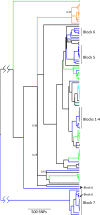Dispersal patterns of Trypanosoma cruzi in Arequipa, Peru
- PMID: 32150562
- PMCID: PMC7082062
- DOI: 10.1371/journal.pntd.0007910
Dispersal patterns of Trypanosoma cruzi in Arequipa, Peru
Abstract
Anthropogenic environmental alterations such as urbanization can threaten native populations as well as create novel environments that allow human pests and pathogens to thrive. As the number and size of urban environments increase globally, it is more important than ever to understand the dispersal dynamics of hosts, vectors and pathogens of zoonotic disease systems. For example, a protozoan parasite and the causative agent of Chagas disease in humans, Trypanosoma cruzi, recently colonized and spread through the city of Arequipa, Peru. We used population genomic and phylogenomic tools to analyze whole genomes of 123 T. cruzi isolates derived from vectors and non-human mammals throughout Arequipa to determine patterns of T. cruzi dispersal. The data show significant population genetic structure within city blocks-parasites in the same block tend to be very closely related-but no population structure among blocks within districts-parasites in neighboring blocks are no more closely related to one another than to parasites in distant districts. These data suggest that T. cruzi dispersal within a block occurs regularly and that occasional long-range dispersal events allow the establishment of new T. cruzi populations in distant blocks. Movement of domestic animals may be the primary mechanism of inter-block and inter-district T. cruzi dispersal.
Conflict of interest statement
The authors have declared that no competing interests exist.
Figures



References
Publication types
MeSH terms
Grants and funding
LinkOut - more resources
Full Text Sources
Medical
Research Materials

